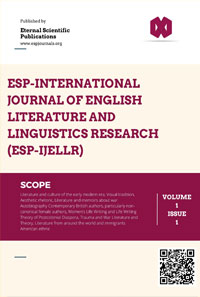ESP International Journal of English Literature and Linguistics Research (ESP-IJELLR)
Citation :
Nicholas, Zachary, 2025. "Environmental Rhetoric in Contemporary Literature: How Nature and Ecology are Represented" ESP-International Journal of English Literature and Linguistics Research (ESP- IJELLR) Volume 3, Issue 3: 36-44.
Abstract :
Environmental sensitivity has been brought to the forefront of contemporary literary and cultural production by an increasingly acute sense of climate change and ecological degradation. To understand how nature and our ecological crises are portrayed in modern literature of the Anthropocene, it explores “environmental rhetoric,” that is language that’s intentionally deployed; visual imagery; narrative form. It covers the way contemporary authors rethink relationships between humans and nature through aesthetic, ethical, and political involvement (relying on eco-critical theories developed by scholars such as Graham Huggan, Timothy Morton, Ursula Heise or Lawrence Buell). Contemporary literature participates directly in the production of ecological substance, rather than simply representing Nature. Writers engage with modes of emotive, ethical, and aesthetic thinking on environmental injustice, sustainability, and planetary interconnectedness via forms as disparate as climate fiction, eco-poetry or postcolonial environmental tales. Polyvocal and speculative types of structurings are utilized in works such as Margaret Atwood’s MaddAddam trilogy and Richard Powers’ The Overstory to dramatize ecosystemic breakdown and recovery. Similarly, the work of Arundhati Roy, Leslie Marmon Silko and Amitav Ghosh situate environmental ruination within expansive histories of colonialism and capitalism as they interweave enviro-storytelling with cultural memory and social comment.Billing and Moraru argue that environmental discourse in literature functions as an ethical imperative, but also a cultural critique. By blending scientific discourse with the lyrical imagination, writers create a rhetorical space in which empathy for non-human existence is necessary for moral comprehension. Some exemplary models of the way that rhythm, metaphor and voice enact ecological consciousness to make language an experience of environmental communion can be found in ecopoetry by writers such as Mary Oliver (1935-2019) or Alice Oswald. Ultimately, ecocritical discourse in contemporary literature fosters an extensive ecological imagination that opposes the anthropocentric perspectives and promotes moral coexistence. The study concludes by claiming that literature reconfigures the human condition in relation to the earth and serves as both an aesthetic and affective engagement with ecological realities. Environmental literature redraws the lines among language, living things, and landscape even as it itself acts as a kind of transformative force in an age of ecological uncertainty.
References :
[1] Atwood, Margaret. MaddAddam Trilogy. Anchor Books, 2013.
[2] Buell, Lawrence. The Environmental Imagination. Harvard University Press, 1995.
[3] Ghosh, Amitav. The Hungry Tide. HarperCollins, 2004.
[4] Harjo, Joy. An American Sunrise. W.W. Norton, 2019.
[5] Heise, Ursula K. Sense of Place and Sense of Planet. Oxford University Press, 2008.
[6] Huggan, Graham, and Helen Tiffin. Postcolonial Ecocriticism: Literature, Animals, Environment. Routledge, 2010.
[7] Kingsolver, Barbara. Flight Behavior. Harper, 2012.
[8] Morton, Timothy. Ecology Without Nature. Harvard University Press, 2007.
[9] Oliver, Mary. Devotions. Penguin, 2017.
[10] Oswald, Alice. Dart. Faber & Faber, 2002.
[11] Powers, Richard. The Overstory. W.W. Norton, 2018.
[12] Robinson, Kim Stanley. The Ministry for the Future. Orbit, 2020.
[13] Roy, Arundhati. The God of Small Things. IndiaInk, 1997.
[14] Silko, Leslie Marmon. Ceremony. Penguin, 1977.
[15] Slovic, Scott. Going Away to Think: Engagement, Retreat, and Ecocritical Responsibility. University of Nevada Press, 2008.
[16] Tiffin, Helen. Five Emus to the King of Siam: Environment and Empire. Rodopi, 2007.
[17] Glotfelty, Cheryll, and Harold Fromm, eds. The Ecocriticism Reader: Landmarks in Literary Ecology. University of Georgia Press, 1996.
[18] Garrard, Greg. Ecocriticism. Routledge, 2012.
[19] Wright, Alexis. The Swan Book. Giramondo, 2013.
[20] Nixon, Rob. Slow Violence and the Environmentalism of the Poor. Harvard University Press, 2011.
Keywords :
Postcolonial Ecology; Anthropocene; Environmental Ethics; Ecological Imagination; Environmental Literature; Nature Representation; Climate Fiction Environment al PoetryEnvironmental Rhetoric Eco-criticism.


 :10.56472/25842773/IJELLR-V3I3P105
:10.56472/25842773/IJELLR-V3I3P105